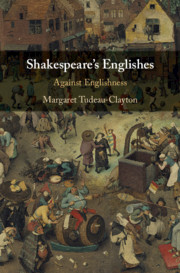Book contents
- Shakespeare’s Englishes
- Shakespeare’s Englishes
- Copyright page
- Epigraph
- Contents
- Table and Illustrations
- Acknowledgements
- Chapter 1 Introduction
- Chapter 2 Shakespeare and ‘the King’s English’
- Chapter 3 Shakespeare and ‘the true-born Englishman’
- Chapter 4 ‘they bring in straing rootes’
- Chapter 5 Figures and Parables of a ‘straing’ Word
- Bibliography
- Index
Chapter 5 - Figures and Parables of a ‘straing’ Word
Shakespeare’s ‘extravagancy’
Published online by Cambridge University Press: 07 October 2019
- Shakespeare’s Englishes
- Shakespeare’s Englishes
- Copyright page
- Epigraph
- Contents
- Table and Illustrations
- Acknowledgements
- Chapter 1 Introduction
- Chapter 2 Shakespeare and ‘the King’s English’
- Chapter 3 Shakespeare and ‘the true-born Englishman’
- Chapter 4 ‘they bring in straing rootes’
- Chapter 5 Figures and Parables of a ‘straing’ Word
- Bibliography
- Index
Summary
This chapter explores Shakespeare’s ‘straing’ linguistic practices through which the drive to homogeneity of cultural reformation ideology is resisted. Illustrated by a family of figures these practices traverse proper and proprietorial boundaries, tending to the production of ‘our English’ as a mobile, expanding and inclusive ‘gallimaufry’. They also carry emancipatory as well as empowering implications, which are highlighted by two discourses with which they are associated. On the one hand, the discourse of ‘manage’ (horsemanship) is turned to advocate an emancipatory poetics of ‘straying’. On the other hand, verbal ‘straying’ is associated with the biblical genre of ‘the parable’, specifically the parables referenced in The Two Gentlemen of Verona. The chapter closes with an analysis of this play, which aligns Shakespearean comedy as well as his ‘straying’ linguistic practices with ‘the parable’, and in particular with the liberating, inexhaustible debt-gift economy of the plot of redemption illustrated by the referenced parables. In relation to this economy the ‘charism’ of the figures of Holofernes and Falstaff and of the author that shadows them is considered in conclusion.
Keywords
- Type
- Chapter
- Information
- Shakespeare's EnglishesAgainst Englishness, pp. 175 - 218Publisher: Cambridge University PressPrint publication year: 2019



